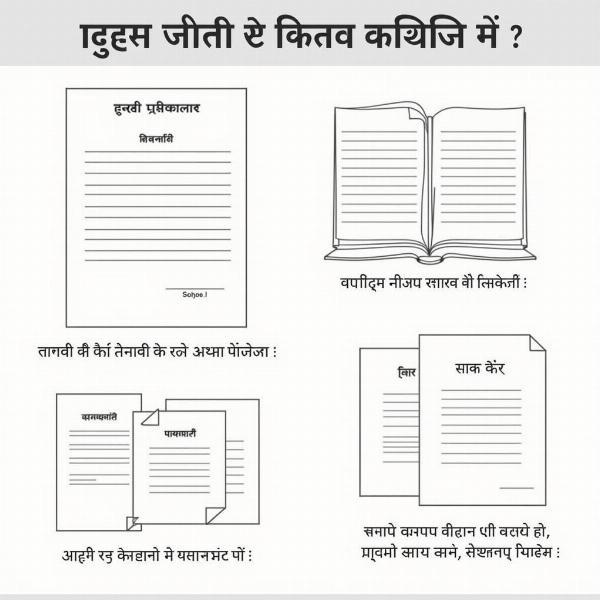Understanding the meaning of “pleadings” is crucial in the Indian legal context. This article explores the meaning of “pleadings” in Hindi, its significance in legal proceedings, different types of pleadings, and practical examples to solidify your understanding.
What Does Pleadings Mean?
“Pleadings” in Hindi is generally translated as लिखित कथन (likhit kathan) or वाद-विवरण (vad-vivaran). These terms essentially refer to the formal written statements submitted by both parties (plaintiff and defendant) in a lawsuit, outlining their claims and defenses. These documents form the foundation of the legal case and define the issues to be addressed by the court. A clear understanding of pleadings meaning in hindi is essential for anyone navigating the Indian legal system.
 Example of Pleadings Document
Example of Pleadings Document
Why are Pleadings Important?
Pleadings play a vital role in ensuring a fair and efficient legal process. They provide clarity, focus, and structure to the legal dispute. By clearly defining the issues at stake, pleadings prevent ambiguity and ensure that both parties are fully aware of the arguments being presented. This transparency promotes fairness and allows for a more focused and efficient resolution of the dispute.
Key Functions of Pleadings
- Framing the Issues: Pleadings clearly define the specific points of contention between the parties.
- Preventing Surprise: By laying out their arguments in advance, parties avoid surprising each other with unexpected claims or defenses during the trial.
- Narrowing the Scope: Pleadings help to narrow the scope of the dispute, focusing the court’s attention on the relevant legal and factual issues.
- Expediting Proceedings: Well-drafted pleadings can significantly expedite the legal process by eliminating unnecessary arguments and streamlining the trial.
Types of Pleadings
Various types of pleadings exist within the Indian legal framework. Some common ones include:
- Plaint (वाद पत्र – vad patra): The initial document filed by the plaintiff initiating the lawsuit and outlining their claims against the defendant.
- Written Statement (लिखित कथन – likhit kathan): The defendant’s response to the plaint, admitting or denying the allegations and presenting their defenses.
- Replication (प्रतिकृति – pratikriti): The plaintiff’s reply to the written statement, addressing any new points raised by the defendant.
- Rejoinder (उत्तर-प्रतिकृति – uttar-pratikriti): The defendant’s response to the replication, addressing new arguments introduced by the plaintiff.
Pleadings Meaning in Law in Hindi: Practical Examples
Let’s consider a scenario where a landlord sues a tenant for unpaid rent. The landlord’s plaint (vad patra) would outline the details of the tenancy agreement, the amount of rent owed, and the period for which it is due. The tenant’s written statement (likhit kathan) might deny the claim, arguing that the rent has been paid or that there are justifiable reasons for non-payment. This exchange of pleadings clarifies the dispute for the court.
“A clear understanding of the local legal terminology is paramount,” says Advocate Shyam Sharma, a seasoned lawyer practicing in Delhi. “Using the correct Hindi terms like ‘likhit kathan’ ensures effective communication within the legal system.”
Common Misconceptions about Pleadings
There are some common misconceptions about pleadings, such as:
- Pleadings are just formalities: While following a specific format is important, pleadings are much more than mere formalities. They are the bedrock of the legal case.
- Pleadings can be easily amended: Amending pleadings can be a complex process requiring court approval. It’s crucial to draft them accurately from the start.
- Pleadings are not crucial for success: The quality of pleadings can significantly impact the outcome of a case. Clear, concise, and well-supported pleadings can strengthen a party’s position.
Conclusion
Understanding “pleadings meaning in hindi” (लिखित कथन or वाद-विवरण) is essential for anyone involved in legal proceedings in India. Pleadings are the foundation of a legal case, defining the issues and shaping the course of the proceedings. Clear and concise pleadings contribute to a fair and efficient resolution of legal disputes. By understanding the different types of pleadings and their significance, you can better navigate the Indian legal system.
FAQs
- What is the purpose of pleadings? Pleadings define the issues in dispute, prevent surprises during trial, and expedite the legal process.
- What is the difference between a plaint and a written statement? A plaint is filed by the plaintiff to initiate a lawsuit, while a written statement is the defendant’s response to the plaint.
- Can pleadings be amended? Yes, but amending pleadings requires court approval and can be a complex process.
- What is the significance of using the correct Hindi terminology for pleadings? Using correct Hindi terms like ‘likhit kathan’ ensures effective communication within the Indian legal system.
- Why is it important to have well-drafted pleadings? Well-drafted pleadings can significantly impact the outcome of a case by clearly presenting arguments and supporting evidence.
Related Articles
Meaning-Hindi.in specializes in providing high-quality Hindi translation services for various fields, including legal, business, technical, and academic documents. Our expertise in legal translation ensures accurate and culturally sensitive rendering of legal terminology, like “pleadings meaning in Hindi,” contributing to the success of your legal endeavors. Contact us at [email protected] or call us at +91 11-4502-7584 for professional and reliable Hindi translation services. Meaning-Hindi.in is your trusted partner for all your Hindi translation needs.